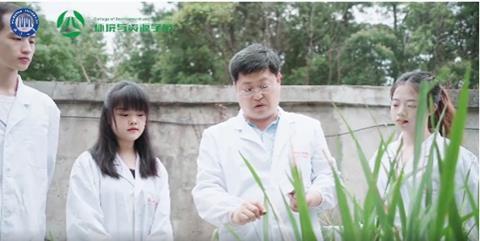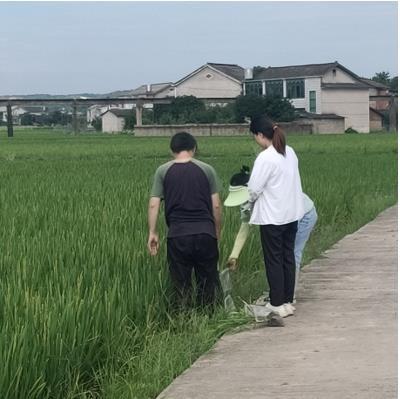Scientists have lifted the lid on how changes in cell surface hydrophobicity of a strain of soil bacterium may help to stave off heavy metal-polycyclic aromatic hydrocarbon pollution from entering rice plant roots.
Dr Feng Li’s team at the College of Environment and Resources, Xiangtan University in China found that Sphingomonas sp. strain PAH02 offers potential as the basis of rhizosphere microbial-enhanced remediation technologies for paddy fields with complex pollution.

The study, ’Metagenomic and proteomic insights into the self-adaptive cell surface hydrophobicity of Sphingomonas sp. strain PAH02 reducing the migration of cadmium-phenanthrene co-pollutant in rice’, appears in Environmental Microbiology, an Applied Microbiology International publication.
Surface hydrophobicity
This paper found that the self-adaptive cell surface hydrophobicity of Sphingomonas sp. strain PAH02 affects the migration and transformation of the cadmium-phenanthrene co-pollutant in the rice rhizosphere and the response processes of the rhizosphere microbiome by simulating the hydrophilic and hydrophobic interfaces of the rice rhizosphere and combining metagenomic and proteomic analysis.
“Cell surface hydrophobicity (CSH) is an important interfacial characteristic. During the long-term symbiosis with the roots of rice, the adaptive changes in CSH of rhizosphere-promoting bacteria in rice endow the plant with the ability to cope with stress from various pollutants,” Dr Li said.
“At present, the co-contamination of heavy metals (HM) and polycyclic aromatic hydrocarbons (PAH) in paddy soil poses a global threat to the quality and safety of rice.
Contaminated paddy soils
“However, in the natural recovery process of co-contaminated paddy soils, researchers have primarily focused on the adsorption, mineralization, and other transformation processes of pollutants by bacteria in the rice rhizosphere micro-zone, neglecting the decisive role of the interfacial properties of rhizosphere bacteria in the remediation process.

“Therefore, elucidating the molecular mechanism by which changes in CSH of rice rhizosphere-promoting bacteria affect the migration and transformation of HM-PAH at the rice root surface interface will become key to improving the stability and sustainability of microbial natural remediation technologies.”
Bacterial strain
Mainly focusing on the cell surface hydrophobicity (CSH) of functional rhizosphere-promoting bacteria in rice, the team selected Sphingomonas sp. PAH02, a bacterium widely present in paddy soil contaminated with heavy metals and polycyclic aromatic hydrocarbons (HM-PAH) and effective in degrading and transforming cadmium-phenanthrene (Cd-Phe). They simulated the hydrophilic and hydrophobic interfaces of the rice root system using glass rods coated with hydrophilic and hydrophobic substances.

Based on the proteomic data of strain PAH02, the study revealed how the bacterium alleviated stress from Cd-Phe co-contamination in the rice rhizosphere through adaptive changes in CSH and identified key proteins involved in regulating this interfacial process.
At the same time, by using soil metagenome sequencing, the research systematically explored the characteristics of the core microbiome in the rhizosphere soil of rice after bioremediation by strain PAH02 and the molecular mechanisms of its interaction with co-pollutants.
Adaptive changes
The research results show that strain PAH02, through its adaptive changes in CSH, reduces the adsorption of the Cd-Phe co-pollutants on the surface of rice roots and simultaneously enhances the degradation of Phe and the adsorption of Cd.
The significant upregulation of key proteins such as MerR, ARHDs, and enoyl-CoA hydratase/isomerase ensures that the adaptive CSH can counter the stress from the Cd-Phe co-pollutants.

At the same time, the authors emphasize that strain PAH02 is a shared core member of the rice soil microbial community, participating in the biogeochemical cycles of rice soil. The bioaugmentation of strain PAH02 promotes the formation of the core microbial community in the rhizosphere soil of rice, such as Bradyrhizobium and Streptomyces, and induces the enrichment of genes closely related to pollutant transformation, such as CusA and PobA genes. After bioaugmentation with strain PAH02, the content of Cd and Phe in mature rice grains decreased by 17.2% and 65.7%, respectively.
Synergistic effects
What particularly struck the researchers was that Sphingomonas sp. strain PAH02 not only plays an important role in its own right in co-contaminated paddy field soils but also can regulate other functional microorganisms to synergistically exert effects in the soil.
“Under the stress of Cd-Phe co-contamination, strain PAH02 primarily reduces the amounts of Cd and Phe on the surface of rice roots by competitive adsorption, while also enhancing the degradation of Phe and the adsorption of Cd on its surface – that is, alleviating stress from Cd-Phe on the rice roots through adaptive CSH changes,” Dr Li said.
“In addition, strain PAH02 can also enhance the formation of the core microbiome in the rhizosphere micro-niche and raise the expression of functional genes such as CusA and PobA that it carries, promoting the degradation and transformation of the co-pollutants, and simultaneously increase the CSH of the core microbiome to strengthen the adsorption or degradation of Cd and Phe.”
Interface properties
“Interface properties affect the transformation of pollutants throughout their entire life cycle in the natural environment, and microorganisms change their surface properties to adapt to environmental changes when responding to pollutant stress,” Dr Li said.
“Importantly, cell surface hydrophobicity is a vital interface property that endows plants or microbes with the superpower to cope with multitudinous biotic and abiotic environmental stresses.
“Understanding the interaction mechanism of cell surface hydrophobicity in reducing the migration of pollutants (especially HM-PAH co-pollutant) in the rhizosphere at a molecular level has become a crucial aspect of addressing the intractable problem of the long-term and steady effectiveness of contaminated soil remediation in fields.
Migration of pollutants
“The conclusions of this study help us understand the migration and fate of pollutants in the environment caused by interface properties. It has significant theoretical value and provides theoretical support for future control of the environmental behavior of these pollutants, thereby providing beneficial guarantees for the safe utilization of paddy soils.”
One limitation of the study is that it is unclear whether the mechanism of adaptive CSH changes of strain PAH02 applies to other rhizobacteria. In addition, future research will concentrate on how strain PAH02 regulates rice gene expression and interacts with rhizobacteria, as well as its long-term effects on rice growth and soil ecosystems.
“These research results lay a theoretical foundation for the development of rhizosphere microbial-enhanced remediation technologies for paddy fields with complex pollution, and also have significant implications for guiding the ecological restoration of polluted rice fields and ensuring food safety,” Dr Li said.
This work was supported by the National Natural Science Foundation of China (No. 22176161), the National Natural Science Foundation of China-Hunan Joint Fund (No. U21A20293), the Natural Science Foundation of Hunan Province (No. 2021JJ30655), the Postgraduate Scientific Research Innovation Project of Hunan Province (Nos. CX20230554 and CX20220599) and the Aid Program for Science and Technology Innovative Research Team in Higher Educational Institutions of Hunan Province.
’Metagenomic and proteomic insights into the self-adaptive cell surface hydrophobicity of Sphingomonas sp. strain PAH02 reducing the migration of cadmium-phenanthrene co-pollutant in rice’ appears in Environmental Microbiology.







No comments yet